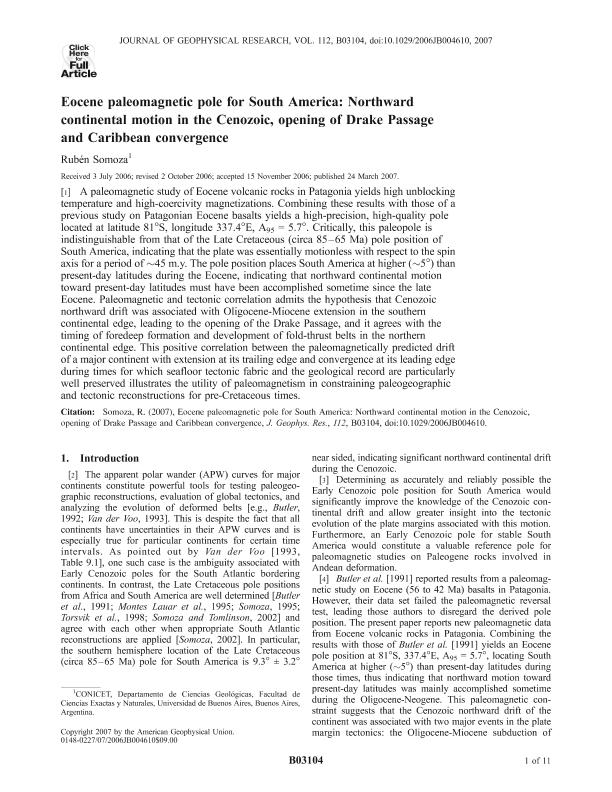Mostrar el registro sencillo del ítem
dc.contributor.author
Somoza, Ruben

dc.date.available
2019-05-21T23:06:21Z
dc.date.issued
2007-03
dc.identifier.citation
Somoza, Ruben; Eocene paleomagnetic pole for South America: Northward continental motion in the Cenozoic, opening of Drake Passage and Caribbean convergence; American Geophysical Union; Journal of Geophysical Research: Solid Earth; 112; 3; 3-2007; 1-11
dc.identifier.issn
0148-0227
dc.identifier.uri
http://hdl.handle.net/11336/76832
dc.description.abstract
A paleomagnetic study of Eocene volcanic rocks in Patagonia yields high unblocking temperature and high-coercivity magnetizations. Combining these results with those of a previous study on Patagonian Eocene basalts yields a high-precision, high-quality pole located at latitude 81°S, longitude 337.4°E, A95 = 5.7°. Critically, this paleopole is indistinguishable from that of the Late Cretaceous (circa 85-65 Ma) pole position of South America, indicating that the plate was essentially motionless with respect to the spin axis for a period of ∼45 m.y. The pole position places South America at higher (∼5°) than present-day latitudes during the Eocene, indicating that northward continental motion toward present-day latitudes must have been accomplished sometime since the late Eocene. Paleomagnetic and tectonic correlation admits the hypothesis that Cenozoic northward drift was associated with Oligocene-Miocene extension in the southern continental edge, leading to the opening of the Drake Passage, and it agrees with the timing of foredeep formation and development of fold-thrust belts in the northern continental edge. This positive correlation between the paleomagnetically predicted drift of a major continent with extension at its trailing edge and convergence at its leading edge during times for which seafloor tectonic fabric and the geological record are particularly well preserved illustrates the utility of paleomagnetism in constraining paleogeographic and tectonic reconstructions for pre-Cretaceous times.
dc.format
application/pdf
dc.language.iso
eng
dc.publisher
American Geophysical Union

dc.rights
info:eu-repo/semantics/openAccess
dc.rights.uri
https://creativecommons.org/licenses/by-nc-sa/2.5/ar/
dc.subject
South America
dc.subject
Paleomagnetic
dc.subject
Eocene
dc.subject
Volcanic Rocks
dc.subject
Patagonia
dc.subject.classification
Meteorología y Ciencias Atmosféricas

dc.subject.classification
Ciencias de la Tierra y relacionadas con el Medio Ambiente

dc.subject.classification
CIENCIAS NATURALES Y EXACTAS

dc.title
Eocene paleomagnetic pole for South America: Northward continental motion in the Cenozoic, opening of Drake Passage and Caribbean convergence
dc.type
info:eu-repo/semantics/article
dc.type
info:ar-repo/semantics/artículo
dc.type
info:eu-repo/semantics/publishedVersion
dc.date.updated
2019-05-02T17:55:45Z
dc.journal.volume
112
dc.journal.number
3
dc.journal.pagination
1-11
dc.journal.pais
Estados Unidos

dc.description.fil
Fil: Somoza, Ruben. Consejo Nacional de Investigaciones Científicas y Técnicas. Oficina de Coordinación Administrativa Ciudad Universitaria. Instituto de Geociencias Básicas, Aplicadas y Ambientales de Buenos Aires. Universidad de Buenos Aires. Facultad de Ciencias Exactas y Naturales. Instituto de Geociencias Básicas, Aplicadas y Ambientales de Buenos Aires; Argentina
dc.journal.title
Journal of Geophysical Research: Solid Earth

dc.relation.alternativeid
info:eu-repo/semantics/altIdentifier/doi/http://dx.doi.org/10.1029/2006JB004610
dc.relation.alternativeid
info:eu-repo/semantics/altIdentifier/url/https://agupubs.onlinelibrary.wiley.com/doi/full/10.1029/2006JB004610
Archivos asociados
